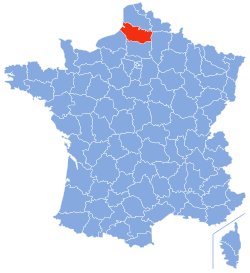
Back Somme (département) Afrikaans Département Somme ALS Somme AN سوم (إقليم فرنسي) Arabic Somme AST Somma (departament) Azerbaijani Département Somme BAR Сома (дэпартамент) Byelorussian Сома (дэпартамэнт) BE-X-OLD Сом (департамент) Bulgarian
You can help expand this article with text translated from the corresponding article in French. Click [show] for important translation instructions.
|
Somme | |
|---|---|
 Prefecture building of the Somme department, in Amiens | |
 Location of Somme in France | |
| Coordinates: 49°53′N 02°25′E / 49.883°N 2.417°E | |
| Country | France |
| Region | Hauts-de-France |
| Prefecture | Amiens |
| Subprefectures | Abbeville Montdidier Péronne |
| Government | |
| • President of the Departmental Council | Stéphane Haussoulier[1] |
| Area | |
| • Total | 6,170 km2 (2,380 sq mi) |
| Population (2021)[2] | |
| • Total | 566,252 |
| • Rank | 44th |
| • Density | 92/km2 (240/sq mi) |
| Time zone | UTC+1 (CET) |
| • Summer (DST) | UTC+2 (CEST) |
| ISO 3166 code | FR-80 |
| Department number | 80 |
| Arrondissements | 4 |
| Cantons | 23 |
| Communes | 772 |
| ^1 French Land Register data, which exclude estuaries, and lakes, ponds, and glaciers larger than 1 km2 | |
Somme (French pronunciation: [sɔm] ; Picard: Sonme) is a department of France, located in the north of the country and named after the Somme river. It is part of the Hauts-de-France region. It is bordered by Pas-de-Calais and Nord to the north, Aisne to the east, Oise to the south and Seine-Maritime to the southwest. To the northwest, its coastline faces the English Channel and it shares maritime borders with Kent and East Sussex in the United Kingdom. It had a population of 570,559 in 2019.[3]
The north central area of the Somme was the site of a series of battles during World War I, including the particularly significant Battle of the Somme in 1916. As a result of this and other battles fought in the area, the department is home to many military cemeteries and several major monuments commemorating the many soldiers from various countries who died on its battlefields. The 1346 Battle of Crécy, a major English victory early in the Hundred Years' War, also took place in this department.
- ^ "Répertoire national des élus: les conseillers départementaux". data.gouv.fr, Plateforme ouverte des données publiques françaises (in French). 4 May 2022.
- ^ "Téléchargement du fichier d'ensemble des populations légales en 2021" (in French). The National Institute of Statistics and Economic Studies. 28 December 2023.
- ^ Populations légales 2019: 80 Somme, INSEE

